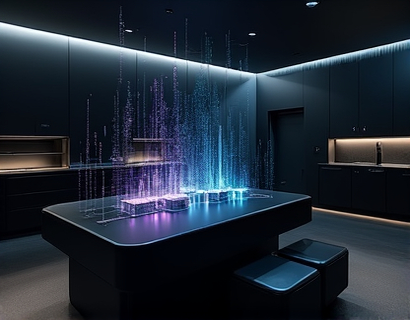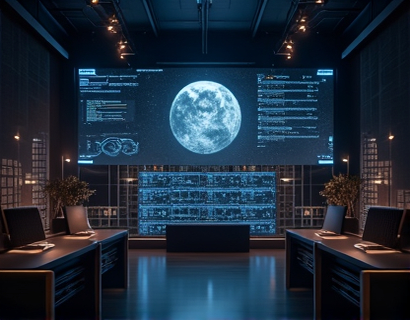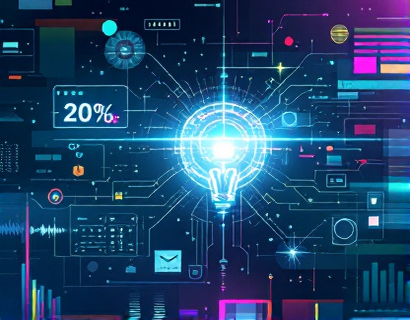Mindful Escape: Harnessing Cutting-Edge Meditation Technology for Stress Relief and Relaxation
In today's fast-paced world, finding moments of peace and tranquility can seem like an elusive goal. The constant barrage of notifications, the pressure to perform, and the demands of daily life can lead to chronic stress and mental fatigue. However, with the advent of advanced meditation technology, individuals can now access powerful tools designed to foster deep relaxation and mental well-being. This article explores the transformative potential of modern meditation software, which combines immersive guided sessions, calming soundscapes, and mindfulness tools to help users achieve a balanced and peaceful state of mind.
The integration of technology in meditation practices has opened up new avenues for stress relief and relaxation. Unlike traditional methods that rely heavily on human guidance, modern meditation software offers a personalized and accessible approach. These platforms are designed to be user-friendly, making it easier for individuals of all skill levels to incorporate mindfulness into their daily routines. The software typically includes a variety of features tailored to promote mental health and reduce stress, such as guided meditations, breathing exercises, and ambient sound environments.
Immersive Guided Sessions
One of the key features of cutting-edge meditation software is the provision of immersive guided sessions. These sessions are led by experienced instructors who guide users through various mindfulness practices, helping them to focus their minds and relax their bodies. The guided nature of these sessions ensures that even beginners can benefit from professional guidance without the need for in-person classes. The software often includes a wide range of themes and durations, allowing users to select sessions that best suit their current needs and available time.
For instance, a user dealing with anxiety might choose a session focused on relaxation and stress reduction, while someone seeking improved sleep might opt for a session designed to promote deep relaxation before bedtime. The guided sessions are typically accompanied by soothing voice instructions, which help users to stay engaged and focused. This combination of auditory and visual cues can significantly enhance the effectiveness of the meditation practice, leading to more profound states of relaxation and mental clarity.
Calming Soundscapes
In addition to guided sessions, modern meditation software often includes a library of calming soundscapes. These soundscapes are carefully curated to create an environment conducive to relaxation and mindfulness. From the gentle sounds of nature, such as flowing water or rustling leaves, to more abstract sound designs, these audio elements can help to mask distracting noises and create a serene atmosphere. The use of high-quality audio recordings ensures that users can fully immerse themselves in the experience, further enhancing the benefits of meditation.
The soundscapes can be used in conjunction with guided sessions or as standalone tools for relaxation. For example, a user might choose to listen to a forest soundscape while practicing a body scan meditation or use a white noise track to help fall asleep. The versatility of these soundscapes makes them a valuable addition to any meditation practice, catering to diverse preferences and environments.
Mindfulness Tools
Beyond guided sessions and soundscapes, meditation software often includes a variety of mindfulness tools designed to support ongoing practice and personal growth. These tools can range from simple timers for setting meditation durations to more advanced features like progress tracking and customizable profiles. By providing these tools, the software empowers users to take control of their mindfulness journey and tailor their practice to their unique needs.
One particularly useful tool is the breath awareness feature, which guides users through breathing exercises to help calm the mind and reduce stress. By focusing on the breath, users can anchor themselves in the present moment, letting go of worries about the past or future. Other tools might include gratitude journals, where users can reflect on positive aspects of their lives, or visualization exercises to foster a sense of inner peace and optimism.
User-Friendly Interface
The success of meditation software largely depends on its user-friendliness. A well-designed interface ensures that users can easily navigate the platform and access the features they need without feeling overwhelmed. Intuitive menus, clear instructions, and a clean layout contribute to a positive user experience, encouraging regular use and long-term engagement. For many individuals, the barrier to starting a meditation practice is the perceived complexity of the process; a user-friendly interface helps to remove this barrier, making mindfulness more accessible to a broader audience.
Moreover, the ability to customize the interface to suit personal preferences can enhance the overall experience. Users can adjust font sizes, choose preferred color themes, and organize their favorite sessions and tools in a way that feels most comfortable for them. This level of personalization not only makes the software more appealing but also helps users to develop a stronger connection with their practice.
Scientific Backing and Effectiveness
The effectiveness of meditation software is supported by a growing body of scientific research. Studies have shown that regular meditation can lead to significant reductions in stress, anxiety, and depression, as well as improvements in sleep quality and overall mental well-being. The mindfulness practices facilitated by these platforms are grounded in established psychological and neuroscientific principles, ensuring that users are engaging in evidence-based techniques.
For example, research has demonstrated that mindfulness meditation can alter brain structure and function, particularly in areas related to attention, emotion regulation, and self-awareness. By consistently practicing mindfulness, users can develop greater resilience to stress and a more balanced emotional state. The data-driven approach of meditation software, which often includes progress tracking and personalized recommendations, further enhances its effectiveness by helping users to stay committed and see tangible results.
Integration into Daily Life
One of the most significant advantages of meditation software is its ability to seamlessly integrate into daily life. Unlike traditional meditation practices that require setting aside dedicated time and space, these platforms allow users to practice mindfulness anywhere, at any time. Whether it's a few minutes of meditation during a lunch break, a guided session before bed, or a quick breathing exercise in a busy office, the software makes it possible to incorporate mindfulness into even the most hectic schedules.
This flexibility is crucial for individuals who may struggle to find consistent time for meditation. By making mindfulness accessible and convenient, the software helps to break down barriers and encourage regular practice. Over time, as users build a consistent routine, they can experience the cumulative benefits of meditation, leading to a more balanced and fulfilling life.
Community and Support
Many meditation software platforms also offer a sense of community and support, which can be invaluable for users on their mindfulness journey. Online forums, discussion groups, and social features allow users to connect with others who share similar goals and experiences. This community aspect provides a space for sharing insights, asking questions, and offering encouragement, fostering a supportive environment that can enhance the overall practice.
Additionally, some platforms offer access to expert instructors and mindfulness coaches through live sessions or pre-recorded content. These interactions can provide valuable guidance and motivation, helping users to deepen their practice and overcome challenges. The combination of community support and professional guidance creates a comprehensive approach to mindfulness, addressing both the practical and emotional aspects of the journey.
Conclusion
In conclusion, cutting-edge meditation technology offers a powerful and accessible means of achieving stress relief and relaxation. Through immersive guided sessions, calming soundscapes, and mindfulness tools, modern meditation software empowers individuals to cultivate a peaceful mind and a balanced life. The user-friendly interface, scientific backing, and integration into daily routines make these platforms an invaluable resource for anyone seeking to enhance their mental well-being. By embracing this technology, individuals can take a proactive step towards reducing stress, improving focus, and fostering a deeper sense of inner peace.










































